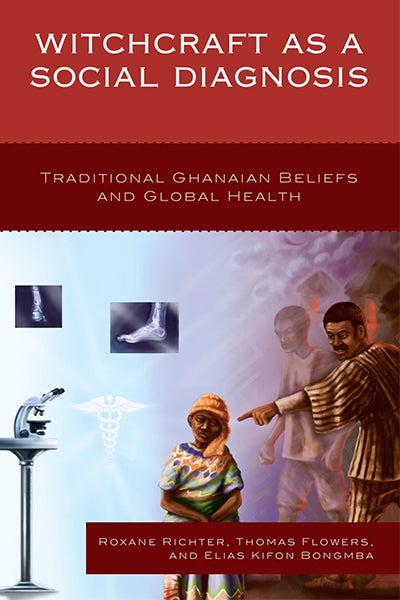Reviewed by Mariah A-K Bender, Department of History
Witchcraft as Social Diagnosis: Traditional Ghanian Beliefs and Global Health by Roxane Richter, a healthcare researcher and president of World Missions Possible, Thomas Flowers, medical director of World Missions Possible, and Elias Bongmba, a professor of religion at Rice University examine how rural challenges in Ghana have global consequences and implications in broader questions of human rights and equality. The text ways women within a particular community in Northern Ghana defined as ‘witches’ were medically undiagnosed and how their conditions were attributed to their accusations by the community as an indication of their involvement in witchcraft. The book’s overview explains that the authors’ methodology includes interacting with self-identified witches who are mostly women and children to “examine the voices of the innumerable people who have been accused, condemned, and sentenced to what many considered a life of marginalized exile, due to illness and disease” (xii). The author’s engagement with the marginalized groups to provide necessary medical treatment was notable and remarked on positively by the participants. The author sources included field notes, government health reports, and structured interviews as sources; but, considering the author’s stated purpose of examining the voices of the marginalized, the voice of the women on their condition or their religious identities were hardly mentioned. Ultimately, Witchcraft as a Social Diagnosis is successful in shining a light on the human rights abuses of women living in these witches’ villages and implicates both local and national officials in the continuation of their oppression and exclusion from Ghanaian society.
However, for scholars of traditional African religion, the text leaves the reader curious to learn more about the specific meaning of witchcraft in the lives of Ghanaian women, and thus, the question of traditional Ghanaian beliefs is not the focus – rather, the role of the Western medical community in diagnosing and treating the women living in Gnani.
Despite the author’s assertion that its necessary to understand witchcraft and its role in Ghana, the field notes from the text and medical researchers’ commentary on the religious practices of the women living in the community, Gnani, do little foster a sense of understanding to the role of religion in women’s lives. The author remarked about the “overwhelming stench of open wounds that were wrapped with any variety of ‘herbal cures.’” (84) This negative reaction to a deeply personal and religiously significant approach to treatment, reveal that the research methodology privileges medical science and western attitudes about the unimportance of traditional religion. Therefore, Witchcraft as a Social Diagnosis falls short in illustrating the meaning of religion or healing in the lives of these marginalized women. Apart from this shortcoming, the text presents several recommendations for NGOs, government groups, and Ghanaian people which will alleviate the exile and marginalization that women living in witches’ villages endure. Ultimately, the authors’ recommendations range from calling for greater anti- witchcraft discourse, establishing voting rights for the exiled witches, and working to shut down the bullying tropes of witches in the media which perpetuate accuses of witchcraft and sentence more women to the margins of society.

